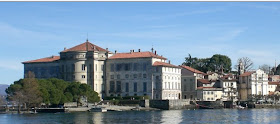Borromean Islands, Golfo Borromeo, the Grand Hotel des Iles Borromees... You can't turn around without running into the name Borromeo here. But just who were these Borromeos? Since you'll encounter them so much, I think it's time that we get to know them a little better.
It seems that the Borromeo family were aristocrats from San Miniato, in Toscana, since at least the 12th century, when the first known records of them appear. But after having been exiled from that area they headed north to Lago Maggiore, where they quickly established themselves in finance and real estate. They soon became well known in the Arona area, and starting to play an important role in the politics of Milan as well as the Catholic Reformation.
1367 - Probably the first member of the family to come to prominence was Filippo who, backed by Holy Roman Emperor Charles IV, led the Ghibellines of San Miniato in their revolt against the Florentine Guelphs. Unfortunately Filippo was captured by the Florentines, and beheaded in 1370. His five children had taken refuge in Milan during the fighting.
1446 - The Duke of Milan, Filippo Maria Visconti, to thank the descendants of Filippo for his
 service and sacrifice, bestowed many gifts and titles to them. Vitaliano Borromeo was made the first Count of Arona in 1446. In 1449 he was also given possession of the Rocca, the large fortress on Lago Maggiore in Angera. For centuries the medieval fortress, and other castles along Lago Maggiore, protected the Borromeans stronghold here.
service and sacrifice, bestowed many gifts and titles to them. Vitaliano Borromeo was made the first Count of Arona in 1446. In 1449 he was also given possession of the Rocca, the large fortress on Lago Maggiore in Angera. For centuries the medieval fortress, and other castles along Lago Maggiore, protected the Borromeans stronghold here.1538 - Carlo Borromeo is born at Rocca di Angera. He is the son of Gilberto, the Count of Arona,
 and Margherita de'Medici, who was the sister of Pope Pius IV. At the age of 22, after spending most of his life in an abbey, Carlo became a Cardinal of the Roman Catholic Church. He will later go on to become the Archbishop of Milan, and a canonized saint. The giant, climbable statue in Arona, the one locals affectionately call Carlone, Big Carlo, is of him. A good man, Carlo was said to have been. He tried to reform the corruptions in the church, and suffered assassination attempts for this. During an outbreak of plague in 1576, Carlo never attempted to protect himself, ministering to the sick instead, and burying the dead. It was of a fever that he himself died, some years later, in 1584. He was canonized in 1610. That's Carlo to the right, painted by Giovanni Ambrogio.
and Margherita de'Medici, who was the sister of Pope Pius IV. At the age of 22, after spending most of his life in an abbey, Carlo became a Cardinal of the Roman Catholic Church. He will later go on to become the Archbishop of Milan, and a canonized saint. The giant, climbable statue in Arona, the one locals affectionately call Carlone, Big Carlo, is of him. A good man, Carlo was said to have been. He tried to reform the corruptions in the church, and suffered assassination attempts for this. During an outbreak of plague in 1576, Carlo never attempted to protect himself, ministering to the sick instead, and burying the dead. It was of a fever that he himself died, some years later, in 1584. He was canonized in 1610. That's Carlo to the right, painted by Giovanni Ambrogio.1600s - While Carlo of course left no heirs, his cousin Federico, and Federico's nephews,
 especially Carlos lll, began the long line of Borromeos to develop and build on the islands they called Isola Bella, Isola Madre, and Isola dei Pescatori.
especially Carlos lll, began the long line of Borromeos to develop and build on the islands they called Isola Bella, Isola Madre, and Isola dei Pescatori.1632 - Count Vitaliano Borromeo begins construction on the fantastic palace and gardens on Isola Bella. That's Vitaliano, painted by Saloman Adler, to the right. By that time the palace on Isola Madre was already almost 100 years old. The islands became a destination for nobility and the rich and famous from all over Europe, thanks to Vitaliano.
Wars, castles, Medicis, cardinals, Popes... The Borromeos have been a part of all of it for almost 1000 years. Direct descendents have lived on the island in the Palazzo Borromeo continuously for all this time. And while no longer officially royalty, the Borromeos, and their rich heritage, have left a lasting mark on this area of northern Italy, are such an integral part of Stresa's history, and they have created many of treasures that people come here to visit today. Tuscany's loss was certainly Lago Maggiore's gain.
